To prevent running-related injuries, an obvious place to start is footwear, however pioneering studies on impact mechanics have found that thicker cushioned running shoes can only dampen impact by 10% at the most!
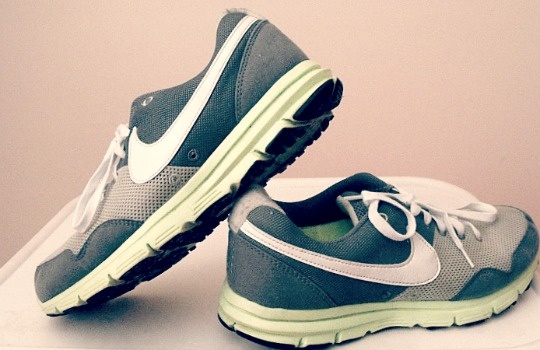
This shocking revelation has caused many injured runners to turn to barefoot and minimalist running because aside from helping the feet build more resilience against tough training, these two running conditions helps you use your forefoot strike most efficiently. This is the most necessary correction because forefoot striking prevents the kind of impacts and other stressors that cause chronic injury.
The good news is, there’s always more a runner can do to prevent injury, and it starts with avoiding heel strike, and instead, land with a forefoot strike (here’s my video showing how to forefoot strike). This is because landing heel-first automatically engages the mechanics directly responsible for nearly all injuries, especially major injuries, like long bone fractures.
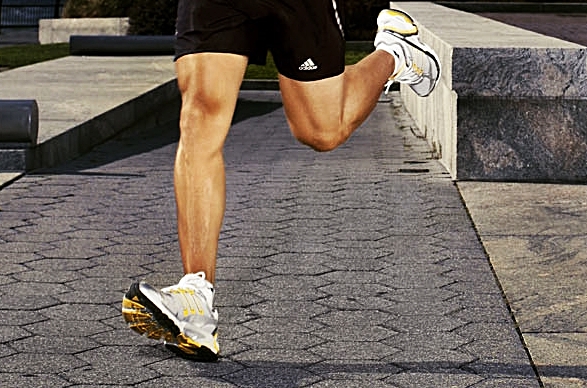
Proper Impact Protection Starts with Foot Strike
The reason the benefits of forefoot running are life-long is because there’s just less all around injurious force components in forefoot running.
In forefoot running, the reductions in net forces are induced by greater knee flexion at landing that engages a shorter stride thereby preventing an over-stride, shown below.
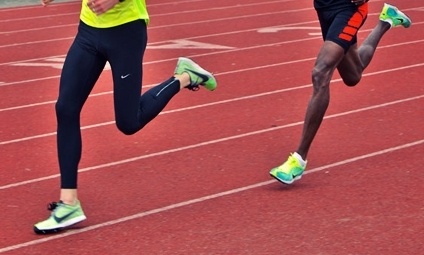
Forefoot striking and greater knee flexion go hand-in-hand as the action of landing on the balls of the foot automatically causes the knee-joint to slightly bend and flex. The functional advantage of this is it closes the distance between your torso (center mass) and your initial foot strike position. This is the only way to keep impact collisions from reaching pain-inducing levels.
This is why forefoot running is well worth trying because impact production during running really depends your foot strike, and landing with a forefoot strike provides its own set of natural protections, whereas the excessive impact produced at landing in heel strike running was found to be the biggest stressor or risk factor that causes nearly all running injuries.
Heel Strike Running Will Always Produce More Impact, Regardless of Footwear
Heel strike runners need extra help to reduce impact because they’ll always generate higher levels of damaging impact forces since a natural mechanical component of landing heel-first is an elongated over-stride, shown below.
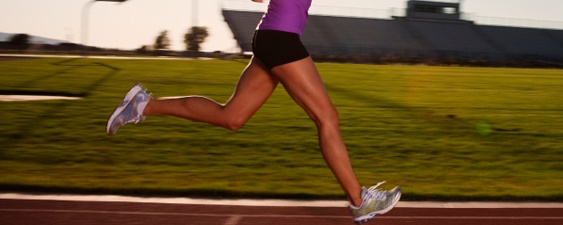

That bulk of excessive impact derives from this landing configuration because when your center of mass ends up farther away from your initial foot strike position, will cause the brake force period to persist much longer in duration, that also produces a shockwave known to render the shin, knee, hip and lower back very vulnerable to injury. Simply put, the body comes to a crashing halt with the ground, and higher levels of braking when running is a main source of injury.
Unfortunately, cushioned running shoes actually fail to help with this. More specifically, the thick cushioned heel fails to dampen the burst in collisional impact (impact peak) at heel strike….
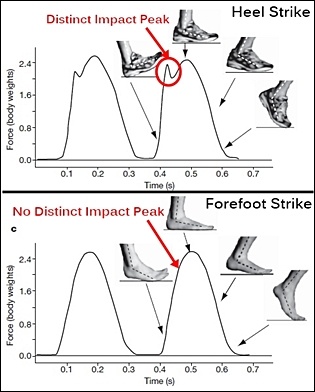
- pioneering studies have found the same basic conclusion in that thick heel cushioning reduces the impact peak by only 10% as this force occurs at a magnitude of 3 times the body weight per heel strike!
- over-striding is a natural by-product of heel strike running, and is proven to be the main culprit for initiating the high burst in collisional impact responsible for most running injuries.
There’s very clear evidence that the impact peak easily penetrates through the cushioned heel, through the heel pad, and converts into a measurable shock-wave that rams through the entire body. The spreading of shock is referred to as shock attenuation.

Yet, the cushioned heel of a running shoe masks the feel of shock, allowing heel strike to feel comfortable. However, the physiological response of the body to the impact of heel striking tells a different story.
- the shock-wave from heel striking causes high vibrational frequencies in soft tissue compartments and bones, resulting in inflammation and discomfort
- to improve shock attenuation, adopting a forefoot running style reduces rapid deceleration and collision forces related to heel strike running, and is why barefoot runners rarely injure, because they all employ a forefoot strike.
Last but not least, the mechanics of the forefoot strike running style adequately dissipates impact due to a flatter foot-placement at touchdown. As a result, the total surface area of contact increases which reduces focal pressure on the heel, while decreasing loading on the joints and ligaments! Read more here about all the other injuries of heel strike running that forefoot running perfectly prevents!

References:
De Wit, B., De Clercq, D and Aerts, P. Biomechanical analysis of the stance phase during barefoot and shod running. J Biomech, 2000; 33(3):269-78.
Murphy, K., Curry, EJ and Matzkin, EG. Barefoot running: does it prevent injuries? Sports Med, 2013; 43(11): 1131-8.
Run Forefoot Because You are Faster than You think!
Bretta Riches
BSc Neurobiology; MSc Biomechanics candidate, ultra minimalist runner & founder of RunForefoot. I was a heel striker, always injured. I was inspired by the great Tirunesh Dibaba to try forefoot running. Now, I'm injury free. This is why I launched Run Forefoot, to advocate the health & performance benefits of forefoot running and to raise awareness on the dangers of heel striking, because the world needs to know.
Latest posts by Bretta Riches (see all)
- Cushioned Running Shoes Found to Be Bad for Ankles - 23/04/2024
- Forefoot Running and Achilles Pain - 19/04/2024
- Does Foot Strike Really Matter in Running? YES! - 17/04/2024

